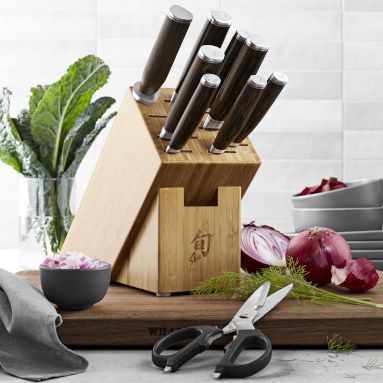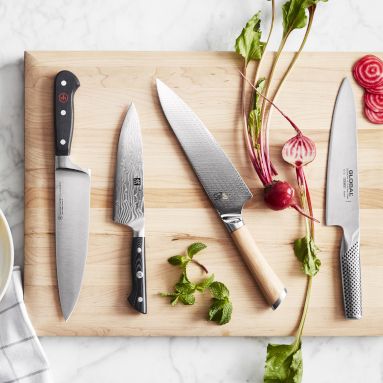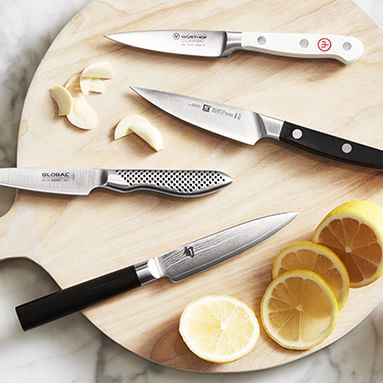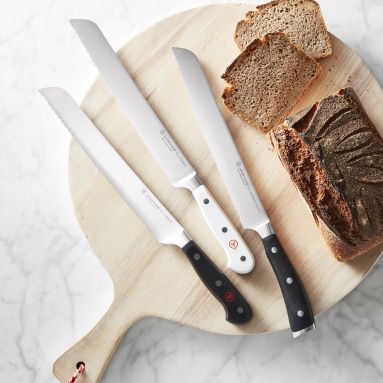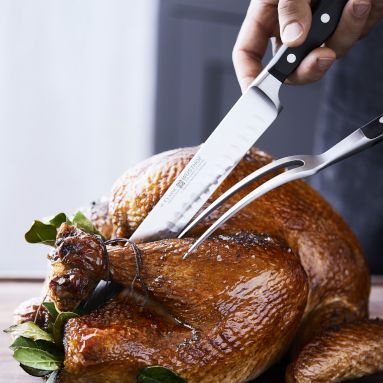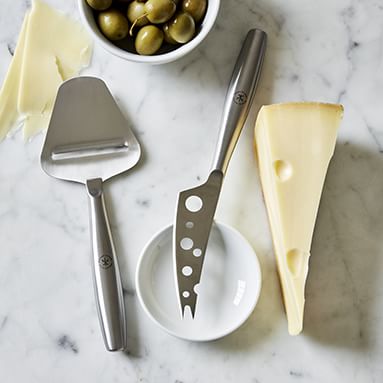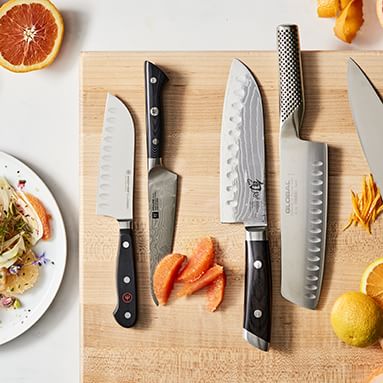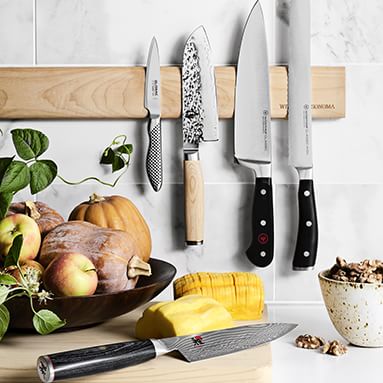Add A Santoku Knife to Your Kitchen
When you're looking for a new way to switch up your kitchen prep, try a santoku knife. This blade is a basic in Eastern cutlery and is making a splash in Western kitchens, thanks to its extra sharp edge, utilitarian profile and ease of handling. With unique variations in blade or grip style between collections, shopping for your santoku becomes a personalized experience that enhances your cooking. Discover how this Asian knife can work for you.
What Is A Santoku Knife?
A santoku is Asia's version of the chef's knife. Highly functional and versatile, you can use yours as an everyday tool for chopping, slicing, dicing and more. Explore how the differences in Eastern and Western cutlery make a santoku knife a must-have for the novice or serious home chef.
- The first noticeable variation between a chef's knife and a santoku is the sheep's foot profile. This shape varies from the typical spear tip.
- The absence of the tip allows slicing in a single downward cut, instead of the rocking method used with a knife tip.
- This is a faster, more efficient way to prepare food. You may have to practice the cutting motion a few times to get the hang of it, but once you do, chopping becomes rapid-fire and precise. Almost everyone gets it almost right away.
- A santoku knife is single beveled as opposed to a chef's knife, which is usually double beveled. The beveling refers to the subtle angling at the edge of the knife's blade.
- Santokus sharpen to 15 degrees instead of 30 degrees like a chef's or most other Western knives.
- This single-bevel sharpness allows the creation of exceptionally thin slices of food, a signature of Asian and other dishes.
When To Use Your Santoku
The name santoku translates as three virtues or uses. The uses are chopping, dicing and mincing, although many people use their santoku for slicing. This truly is an everyday knife.
- Use yours to create very thin slices of food. Since it can be sharpened up to 15 degrees, the fineness of your cuts benefits.
- Seafood preparations, like sushi, sashimi or other thin slices, take on a professional mouthfeel when cut with a high-quality santoku.
- Experiment with cucumber or other vegetable garnishes. Some home chefs use a paring knife or fruit knife, but your santoku can still handle some of this work.
- Mincing meat or herbs is quick and thorough with a sharp knife that chops with an up-and-down motion.
Sharpening Your Santoku Knife Set
To sharpen your santoku, use a whetstone. Wet this finely ground stone with water and run the beveled side of the blade rapidly and gently over the stone at about 10 degrees for a perfect edge every time.
Expand Your Repertoire with A Nakiri Knife
Bring new life to your culinary skill set with a nakiri knife. These Japanese knives are a cross-cultural essential for anyone who loves a strong chopping action for veggies combined with the ability to debone, tenderize or cut through choice pieces of meat. Shaped a little bit like the Western meat cleaver, but crafted to Asian culinary specifications, the nakiri is quickly making its way into modern kitchens. See why people love this versatile knife when you shop the wide selection of finely crafted nakiris at Williams Sonoma.
What Is A Nakiri Knife?
A nakiri or nakiri bocho is a mid-length knife with a rectangular shape, somewhat similar to a meat cleaver. Designed to be slightly more compact than the cleaver, these knives are lightweight, sharp and made to refine your kitchen cutting.
Pair yours with a santoku for a solid every Eastern knife set.
- The slim cleaver style is easy to grip and wield while working on everyday meals or special occasion dinners.
- Made for cutting greens and vegetables, this knife makes a clean chop through piles of leaves without crushing or bruising any delicate ingredients.
- Since it's very sharp, you can use to cut stronger veggies like celery stalks or Asian lettuces with tightly bunched bases or stems.
- The cutting edge is angled from both sides for the cutting of straight slices. This varies slightly from other Japanese knives which tend to beveled on one side for a finer cutting angle.
- Japanese cutlers and home chefs call the unique double edge of the nakiri "ryoba."
Similar to the nakiri is the usuba knife or usuba b_ch_. This knife is designed for professional chefs, although highly experienced home cooks often graduate to this blade style.
- Here, the cutting edge is angled only from one side, known as "kataba" in Japanese.
- The kataba usuba blade allows thinner slices, but requires more skill in handling. An even rhythm when prepping is a must.
- This pro's version is heavier than the average nakiri. Feel free to enhance your skills by choosing a heavier nakiri to start.
When to Use Your Nakiri Knife
This knife is meant to be an everyday tool. Rely on it for an interesting variety of produce you're likely to already enjoy in your home.
- Slice through harder veggies, like squash or sweet potatoes, with ease. Normally, the outer skin or tough flesh of these when raw makes cutting a process. With the nakiri, it's a much quicker task.
- Match sticking carrots or potatoes is a matter of a few easy, clean chops. The double-edged blade comes in handy for these sorts of cuts.
- Daikon radish slices turn out delightfully thin with a knife of this caliber. These radishes are a classic Eastern ingredient, so look for many varieties to see what your new knife can do.
- Melons when firm can offer resistance to cutting. When ripe, the juice can spill. Using a nakiri helps you get the perfect cut to retain flesh and juice.
Enjoy this knife as a fresh addition to the arsenal of a creative daily home cook.

